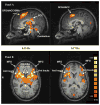Brain activity related to temporal summation of C-fiber evoked pain
- PMID: 17156923
- PMCID: PMC1997296
- DOI: 10.1016/j.pain.2006.10.010
Brain activity related to temporal summation of C-fiber evoked pain
Abstract
Temporal summation of "second pain" (TSSP) is considered to be the result of C-fiber-evoked responses of dorsal horn neurons, termed 'windup'. This phenomenon is dependent on stimulus frequency (0.33 Hz) and relevant for central sensitization and chronic pain. Previous brain imaging studies have only been used to characterize neural correlates of second pain but not its temporal summation. We utilized functional magnetic resonance imaging (fMRI) in healthy volunteers to measure brain responses associated with TSSP. Region of interest analysis was used to assess TSSP related brain activation. Eleven pain-free normal subjects underwent fMRI scanning during repetitive heat pulses to the right foot at 0.33 and 0.17 Hz. Stimulus intensities were adjusted to each individual's heat sensitivity to achieve comparable TSSP ratings of moderate pain in all subjects. As predicted, experimental pain ratings showed robust TSSP during 0.33 Hz but not 0.17 Hz stimuli. fMRI statistical maps identified several brain regions with stimulus and frequency dependent activation consistent with TSSP, including contralateral thalamus (THAL), S1, bilateral S2, anterior and posterior insula (INS), mid-anterior cingulate cortex (ACC), and supplemental motor areas (SMA). TSSP ratings were significantly correlated with brain activation in somatosensory areas (THAL, S1, left S2), anterior INS, and ACC. These results show that neural responses related to TSSP are evoked in somatosensory processing areas (THAL, S2), as well as in multiple areas that serve other functions related to pain, such as cognition (ACC, PFC), affect (INS, ACC, PAG), pre-motor activity (SMA, cerebellum), and pain modulation (rostral ACC).
Figures






References
-
- Arendt-Nielsen L, Petersen-Felix S, Fischer M, Bak P, Bjerring P, Zbinden AM. The effect of N-methyl-D-aspartate antagonist (ketamine) on single and repeated nociceptive stimuli: a placebo-controlled experimental human study. Anesth Analg. 1995;81:63–68. - PubMed
-
- Beck AT, Beamesderfer A. Assessment of depression: the depression inventory. In: Pichot P, editor. Psychological measurements in psychopharmacology. Basel; Karger: 1974. pp. 151–169. - PubMed
-
- Carpenter R. Neurophysiology. London: Hodder Arnold; 2002. pp. 1–320.
-
- Casey KL, Bushnell MC. Progress in Pain Research and Management. Vol. 18. Seattle: IASP Press; 2000. Pain Imaging.
-
- Chudler EH, Dong WK, Kawakami Y. Cortical nociceptive responses and behavioral correlates in the monkey. Brain Res. 1986;397:47–60. - PubMed
Publication types
MeSH terms
Substances
Grants and funding
LinkOut - more resources
Full Text Sources
Medical
Research Materials
Miscellaneous

